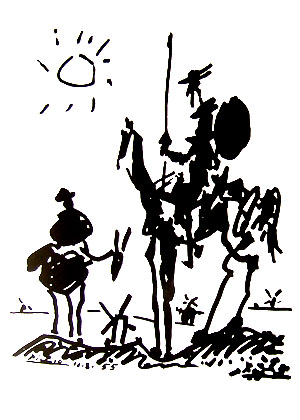Anxiety
Updated Last July 16, 2016
Anxiety brings a deeply-seated subjective sense that something bad will happen. However, so does fear. In casual discussion, the terms anxiety and fear are used interchangeably, but there is an informative energetic distinction to be made. Anxiety is caused by a strong impulse leaving the core and being arrested in the muscular layer. Fear is caused by a strong contraction of the tissues in the face of an external threat (albeit sometimes a remembered, imagined, projected, or social threat) Restated another way, anxiety is from an internal stimulus while fear is from an external stimulus. This difference then indicates a difference in remedies.
Contraction and suffering due to fear is best addressed by 1) removing any identifiable threats, 2) for unidentifiable or irremovable threats, by anger which re-expands the tissue and the organism. Protest is enough at times for healing, but if concrete actions to address the threat are reasonably safe and available, they must not be shirked. Of course, for realistically strong threats, fear and its physiological sequelae may be appropriate.
Anxiety, on the other hand, is best addressed by honoring the triggering impulse. This often involves bringing it to consciousness but if that is not possible, general constructive actions are helpful. Preferably, these are directed at the person or obstacle that seems to have triggered the impulse. However, any truly constructive life-affirming action can suffice. Now in any case, anxiety tends to produce the sense that something needs to be done (which further distinguishes it from fear which tends toward paralysis and inhibition) Four types of actions tend to be undertaken to satisfy this sense:
- Compulsive Actions These are familiar habitual actions that tend to be used frequently. Examples might be constant working, vacuuming, or exercise. Actions are in place of the original impulse
- Impulsive Actions These sudden discontinuous actions that may seem to offer a new beginning. Examples are a geographic move or a quick marriage. Again actions are in place of' the original impulse (here the root word 'impulse' is used in two different meanings)
- Mood Change This is the realm of addiction or escape, such as drugs, alcohol, porn, video gaming etc...
- Constructive Actions These are in themselves novel actions but in line with actual conflicts, or at least in line with true pleasure and growth. Examples are leaving a bad relationship (and not jumping into another relationship) or talking frankly to one's boss about duties, promotions etc...
While all actions reduce anxiety in the moment, only constructive actions prevent its recurrence. Anxiety leads to anxious, ruminating thoughts, but the content of these thoughts tend toward more superficial conflicts and the are usually not the root cause of the anxiety. Unlike action, thought does not resolve anxiety to any degree and may increase it. In the body, anxiety is most strongly felt in the chest, followed by the rest of the torso and the temples. Anxiety may not be obvious at lower intensities. There are three ways in which anxiety makes itself known:
- Anxiety Trail This is where living is filled with multiple actions and transactions that are meant to quell or distract from anxiety. Examples are restlessness, novelty-seeking, workaholism, zealotry, addiction or compulsive behavior, rage, judging, moralizing, blaming, codependency, control, relationship drama, etc.. At this level the anxiety is often not appreciated by the holder. It may be appreciated by astute others. Generally, though, the behavior is attributed to moral failing or moral virtue.
- Anxiety State This is a feeling of diffuse, debilitating fear, a nameless dread, or a feeling of impending doom, and a wobbly, shaky feeling. This state obviously is felt by the holder. Anxiety state is more associated with inaction (whereas anxiety trail is more associated with action)
- Panic. This is a condition where, for no present external cause, a flight or fight reaction occurs, with release of adrenaline. There is rapid breathing, chest constriction, throat constriction, increase in heart rate, increase in force of contraction of the heart, and nausea. Panic is not sustainable and will abate on its own, although it can be terrifying. This is why it is called a panic attack. It can be helpful for sufferers to understand that panic is the physiology of their own bodies, not a judgment or warning of the universe (which is what the thoughts usually tend toward).
In the Reich and Lowen tradition, anxiety is seen as a sign of life, albeit a painful one. The generally advised approach to anxiety is then increasing the body's (and ego's) tolerance for energy, life and feeling. Where baseline anxiety is high, lifestyle tends to be busy or frenetic but without any pleasure or satisfaction.. At that point, trying just to be uncovers considerable anxiety. That is why 'doing nothing' when disquieted can be so beneficial, it allows conflicts and motives to surface, but the price is tolerating some distress. For most people, strong anxiety is uncovered when character defenses start to fail, either because the external stress or shock is great enough, or the character has been softened with bodywork and character analysis. Strong character-dystonic impulses emerge which cause panic and disorientation. A goal of therapy is to avoid large jumps in anxiety, but no progress can be made without some anxiety.
Bodywork in the Reich and Lowen tradition can both cause and release anxiety at times, but it leads eventually to authentic living in which anxiety plays only a minor role. Drug therapy, in contrast to bodywork, is dysregulating and up-regulating. and inevitably leads to greater anxiety. Stimulants reduce anxiety in the short-run perhaps by spurring activity, but of course stimulants increase anxiety in the medium and short run. Sedating drugs and opiates including endorphins quell anxiety briefly but again in the medium and long run increase it through up-regulation.
